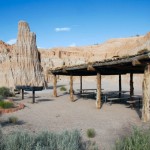Cathedral Gorge State Park
 Cathedral Gorge State Park is located in eastern Nevada, about 1 mile north of the intersection of Highway 93 and State Route 319. The park is compromised of approximately 1,608 acres. It gets its name from the many spires and pillars that have been carved into the clay cliffs by many centuries of water running through it. The gorge is the remainder of a lake bed from the Pliocene era, which was a time that was anywhere from 2.5 to 5 million years before today.
Cathedral Gorge State Park is located in eastern Nevada, about 1 mile north of the intersection of Highway 93 and State Route 319. The park is compromised of approximately 1,608 acres. It gets its name from the many spires and pillars that have been carved into the clay cliffs by many centuries of water running through it. The gorge is the remainder of a lake bed from the Pliocene era, which was a time that was anywhere from 2.5 to 5 million years before today.
Cathedral Gorge is a high desert park and lies at an elevation of about 3,800 feet. Summer temperatures range from 93 degrees fahrenheit during the day to 55 degrees fahrenheit at night. Rain falls at random while thunderstorms are quite common.
Cathedral Gorge was once home to the town of Panaca, which was settled by Mormon pioneers in 1864. In 1867, silver ore was discovered nearby and led to the establishment of Bullionville in 1869. Remnants of this mining town are still visible today, just east of the park entrance. The town’s cemetery is located north of the park, just off of highway 93.
During the 1920s, Cathedral Gorge was a very popular venue for hiking, picnicking, and open-air plays. Vaudeville shows and even Shakespearean plays were rehearsed and performed here, with the nooks and crevices used as dressing rooms and backstage and the canyons themselves as the backdrop. In the 1930s, the Civilian Conservation Corps (CCC) built a camp on these grounds. Many of the stone structures, such as the stone water tower and many other buildings, can still be seen today. The currently used picnic area includes a large ramada for shade and picnic tables and was also built by the CCC. Cathedral Gorge became a recognized State Park in 1935 and was one of the first for Nevada.
Cathedral Gorge State Park has many different species of plant life due to its differing soil compositions and high elevation. The soft bentonite clay erodes constantly so many plants cannot take root. Wildflowers and grasses maintain small sand dunes in other places. The valley is composed of clay, gravel, sand, and soil. Yucca, juniper trees, sagebrush, shadscale, and many other plants thrive here. The campgrounds were planted with many non-native species of trees to create shade. Although it is a desert, few cactus species can survive here due to its climate extremes and elevation.
The park is abundant with native birds such as hawks, black-throated sparrows, songbirds, kestrels, and roadrunners. Migratory birds also enter the gorge including tanagers, hummingbirds, starlings, and bluebirds. Small mammals such as jackrabbits, cottontail rabbits, coyote, foxes, skunks, rats, and gophers frequent the park. Deer graze every now and then, especially around Miller Point, although many enter the Gorge during late fall and winter. There are also many types of nonpoisonous lizards and snakes, however in the summer, the Great Basin Rattlesnake can be found as well.
Cathedral Gorge State Park offers amenities for camping, picnicking, and hiking. Camping is on a first-come, first-served basis. The park offers 22 developed areas for camping and each includes a table, grill, and ramada. A 4-mile long loop trail allows hikers to visit remote areas of the park. Another trail, approximately 1-mile long, leads from the Miller Point Overlook to the CCC Picnic Area.
Cathedral Gorge State Park is open 24 hours a day, 365 days a year. Fees are charged for day use and overnight camping. The grounds are complete with designated camping areas, fire rings, grills, and garbage dumpsters. The visitor’s center is open from 9:00am to 4:30pm and includes exhibits on the history, culture, and natural resources of eastern Nevada. There are no food or supplies in the park.
For more information about Cathedral Gorge State Park, visit http://parks.nv.gov/cg.htm or call 775 728 4460. The park can be mailed at P.O. Box 176 Panaca, NV 89042.
